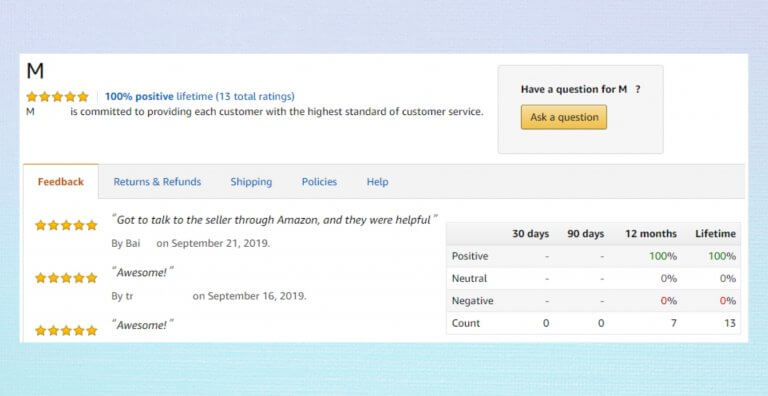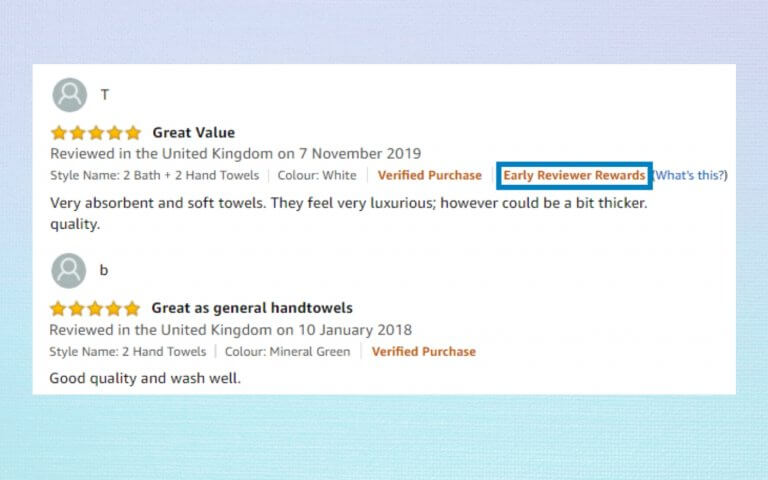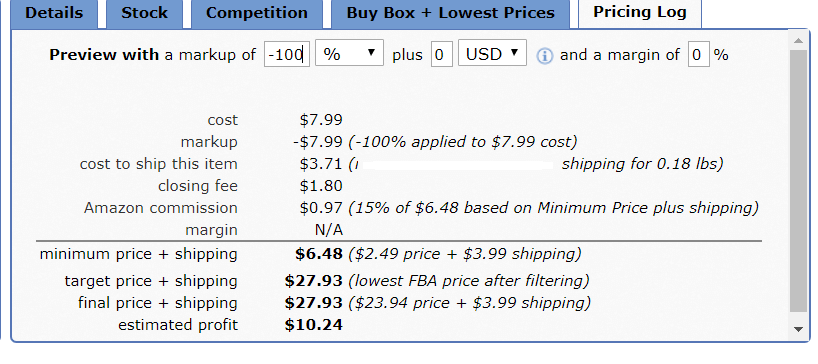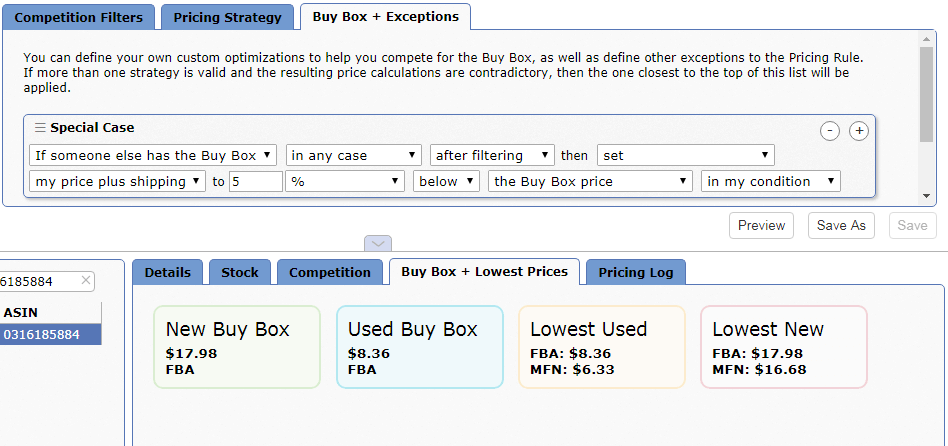For many Amazon sellers, staying competitive on Amazon is becoming a challenge. But for newcomers, this reshuffle is a good opportunity to sell on Amazon in 2020 and come out on top. Here are a few Amazon selling tips from us.
Last quarter, sellers accounted for half of Amazon’s transactions, according to Statista. But today, many businesses are clinging for survival.So, Q2 figures could look very different. If you’re a newcomer, this is good news. But less competition is not reason enough for your products to sell on Amazon in 2020.
Becoming and staying competitive on Amazon is a must if you want to last. And there are limits to what you can do to draw buyers to your business on Amazon.
But you can’t go wrong if you follow these 7 Amazon selling tips.
Here’s how to set yourself apart from the get-go:
7 Amazon Selling Tips for Competitive Sellers
Build Up Your Feedback Score

A good feedback score will bring more orders your way.
And a reputation for prompt, high-quality customer service might also make disgruntled buyers think twice before going public.
But there are a few reasons why newcomers may find it harder to build a good feedback score on Amazon in 2020:
- More people are shopping on the Amazon app, where there’s no option to leave seller feedback.
- People are buying more on Amazon, and the more they buy the less time they have for feedback.
- The ‘Amazon effect’ means buyers expect more from sellers, including new ones.
- Buyers are more likely to leave negative feedback during the pandemic.
- People’s shopping habits are shifting due to lockdowns and changes in their circumstances.
- Global supply chains are disrupted and may not revert to ‘normal’ for some time.
To mitigate these issues, you should embrace automation.
For instance, you could send automatic thank you emails after receiving orders and/or feedback requests a couple of days after delivery. But you should also harness your soft skills where needed (e.g. customize your packing slips with handwritten messages).
Encourage Product Reviews
It’s been said before, but it’s worth repeating. You need genuine, objective reviews, with photos or videos. You should try to boost the tally without breaking the rules.
For instance, you can offer exclusive discounts for existing customers, swag bags for influencers, and freebies for reviewers.
But remember: your offer shouldn’t be contingent on positive reviews. Also, you shouldn’t know the reviewers personally. And you’re not allowed to use reviews websites.
But most importantly, none of your employees or associates are allowed to use ‘black hat’ tactics to solicit reviews either.

Get to Know Your Competition
Once you’ve built up your reputation, it’s time for thorough competitor analysis.As we explained in our earlier blog post, you can start by counting FBA and FBM offers. Then check your competitors’ storefronts, business backgrounds, estimated sales volume, listings, keywords, and promotions. You could also place a few test orders to see how and where they ship from, and what packing supplies they use.
Price Competitively
Another Statista survey report claims that there are 4 main reasons people shop on Amazon: they get free shipping, product variety, Prime benefits, and better prices. And because price matters, most seasoned sellers use repricing software. This tool takes over the task of adjusting prices based on the competition. The main advantage of using repricing software tools is that they work round the clock, saving you a great deal of time. So, you don’t need to keep checking and tweaking your prices, however large your inventory.Then there’s also the fact that they give you valuable sales data that’s easy to visualize.
Most importantly, Amazon sellers use automatic repricers to boost sales and profits. They can spot a change in a competitor’s price as soon as it happens. So, they can bring your price back into line quickly. There’s one major caveat with these repricers though: it takes time for price adjustments to go live.
This lag usually takes several minutes. With Sellery, there’s no lag. This means that Sellery can change your price faster than your competitor, giving you more time in the spotlight.

Another feature unique to Sellery is that it automatically calculates all your Amazon fees, shipping expenses, and other costs. As soon as Amazon updates FBA and FBM fees, Sellery takes them into account. So, whatever margins and markups you choose for your listing, your costs are always accurate.

And here’s the best part. Unlike other repricers, Sellery doesn’t get caught up in price wars. That’s because it calculates a minimum price for you based on what it would cost you to fulfil an order on your chosen venue, as well as your margins and markups. And it never goes below this minimum price.
Finally, Sellery is also Private Label friendly.
It enables you to compare different ASINs on Amazon. So, you can price your items based on similar listings.
With Sellery, you can view listings back-to-back and decide which private label seller to compete with, as seen in this video.
Win the Buy Box
Most transactions on Amazon go through the Buy Box. It’s the default option for customers who check out without looking at the offers page. Think of it as the featured offer. It’s free, you can access it if you’re eligible, and it operates on what is known as the elusive Buy Box rotation system.
Unfortunately, if you don’t know who owns the Buy Box at any given moment, you can’t match or undercut them. So, your chances of selling your item fall dramatically. But Sellery can help with that too. It shows you the Buy Box for every Condition. That’s right, there’s a Used Buy Box too!

Offer Plenty of Perks
According to Statista, there were 150 million active Prime members last year, mostly based in the USA.
And according to Marketpulse, there were nearly 3 million active sellers on Amazon, about a third of which were in the USA.
So, there’s ample scope for growth for sellers who pamper their Prime customers.
Aside from free shipping and volume discounts, up-and-coming sellers should consider the FBA Subscribe and Save program. This program enables sellers to build up a pool of loyal customers. Bear in mind that repeat customers can rate the seller’s service time and again, but only review a product once.
There’s one shopping fad that’s quickly gaining momentum during the lockdown: the subscription box. It’s a bespoke selection of products based on the customer’s profile. If you want to sell subscription boxes on Amazon, then bear in mind that the A-to-Z guarantee applies to these listings as well.
Advertise on Amazon
Advertising is Amazon’s fastest-growing department. And it’s an option you should seriously consider if you want to promote your product on Amazon. But as this Guide to Amazon Advertising explains, not every advertising option is right for a new seller.
If you sign up for Brand Registry, you gain access to consoles like Amazon Attribution, Creative Manager, and the Amazon DSP platform. They enable you to manage Amazon CPM campaigns like video and display ads. You can even use them to create and analyze off-Amazon ads.
But most new sellers only really have one option: PPC (pay-per-click) campaigns. These are free ads displayed on Amazon search pages. The seller only pays Amazon when a user clicks on them. There are two such types of campaigns on Amazon. Depending on the choice of campaign, an ad will look like this:
- Sponsored Brands – banner at the top of a search page, with the brand’s logo and USPs.
- Sponsored Products – search result displayed preferentially at the top or bottom of the page.
Both campaigns have their perks. But for new sellers, it’s probably best to use them together, at least at the beginning. And Amazon advises running several of each type, just to get a feel for what the customer is looking for and the keywords you should bid on.
But before you invest in Amazon Advertising, be aware that the average seller spends $381 per day on ads, according to Ad Badger. If you go toe-to-toe with them, your costs could quickly spiral out of control. So, read up on Advertising Cost of Sale (ACoS), click-through rate (CTR), and bidding controls.
As we made clear in our recent blog post titled Is Amazon PPC Worth It?, there are pros and cons to advertising on Amazon. While campaigning is an essential part of staying competitive on Amazon, it’s best to diversify ad spend. So, at the risk of repeating ourselves, please keep your options open.
Against a backdrop of rattled supply chains and fragile economies, it’s important to be proactive if you’re going to sell on Amazon in 2020.
So, for more Amazon selling tips, please follow our blog post. And keep an eye out for Part 8 of our ‘How to’ series, where we discuss performance metrics and suspensions.
Subscribe to Our Blog

Melanie takes an active interest in all things Amazon. She keeps an eye on the latest developments and keeps Amazon sellers up to speed.
The post How to Sell on Amazon in 2020: Staying Competitive on Amazon appeared first on SellerEngine.
Source



